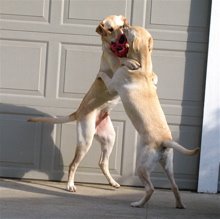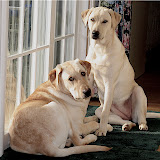Dog "Tails" . . . It's more than just a wag
Who knew . . .
In a recent New York Times article, "If You Want to Know, if Spot Loves You So, It’s in His Tail" (Published: April 24, 2007) Sandra Blakeslee explains the current science behind understanding dog tail wags.
Did you know . . . ?
When dogs feel fundamentally positive about something or someone, their tails wag more to the right side of their rumps. When they have negative feelings, their tail wagging is biased to the left.The article is fascinating in that it goes on to explain that this right brain vs. left brain distinction in various circumstances also exists in many species.
Research has shown that in most animals, including birds, fish and frogs, the left brain specializes in behaviors involving what the scientists call approach and energy enrichment. In humans, that means the left brain is associated with positive feelings, like love, a sense of attachment, a feeling of safety and calm. It is also associated with physiological markers, like a slow heart rate.
At a fundamental level, the right brain specializes in behaviors involving withdrawal and energy expenditure. In humans, these behaviors, like fleeing, are associated with feelings like fear and depression. Physiological signals include a rapid heart rate and the shutdown of the digestive system.
One of the scienfitic anatomical explanations is that . . .
The asymmetry may also arise from how major nerves in the body connect up to the brain, said Arthur D. Craig, a neuroanatomist at the Barrow Neurological Institute in Phoenix. Nerves that carry information from the skin, heart, liver, lungs and other internal organs are inherently asymmetrical, he said. Thus information from the body that prompts an animal to slow down, eat, relax and restore itself is biased toward the left brain. Information from the body that tells an animal to run, fight, breathe faster and look out for danger is biased toward the right brain.Go check out the whole article, it's a facinating read.
you do now!












1 comment:
I guess there is a lot of complexity going on it those teeny little dog brains. Maybe I should give the dogs more respect for intellectual prowess. Good post.
Post a Comment